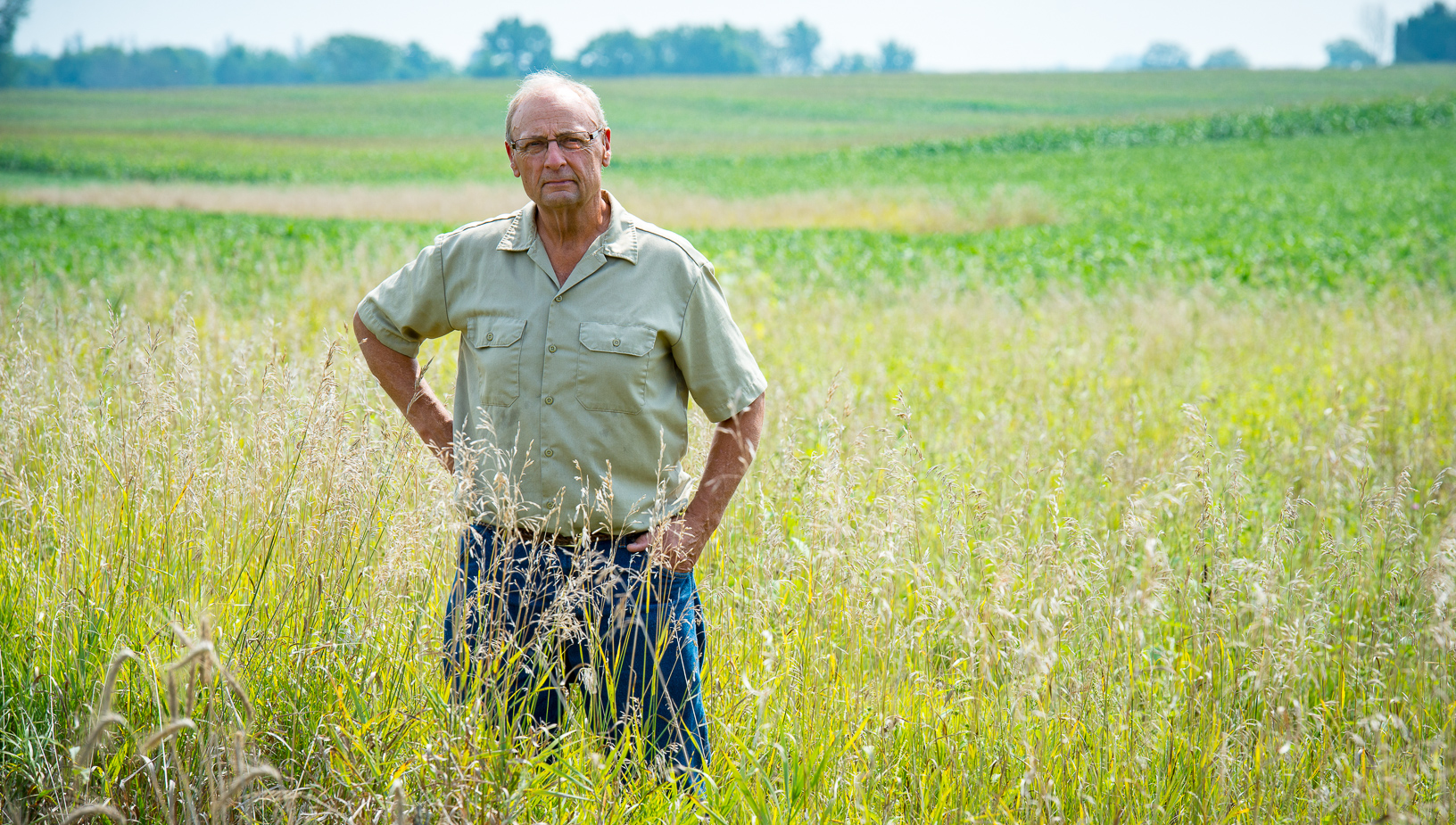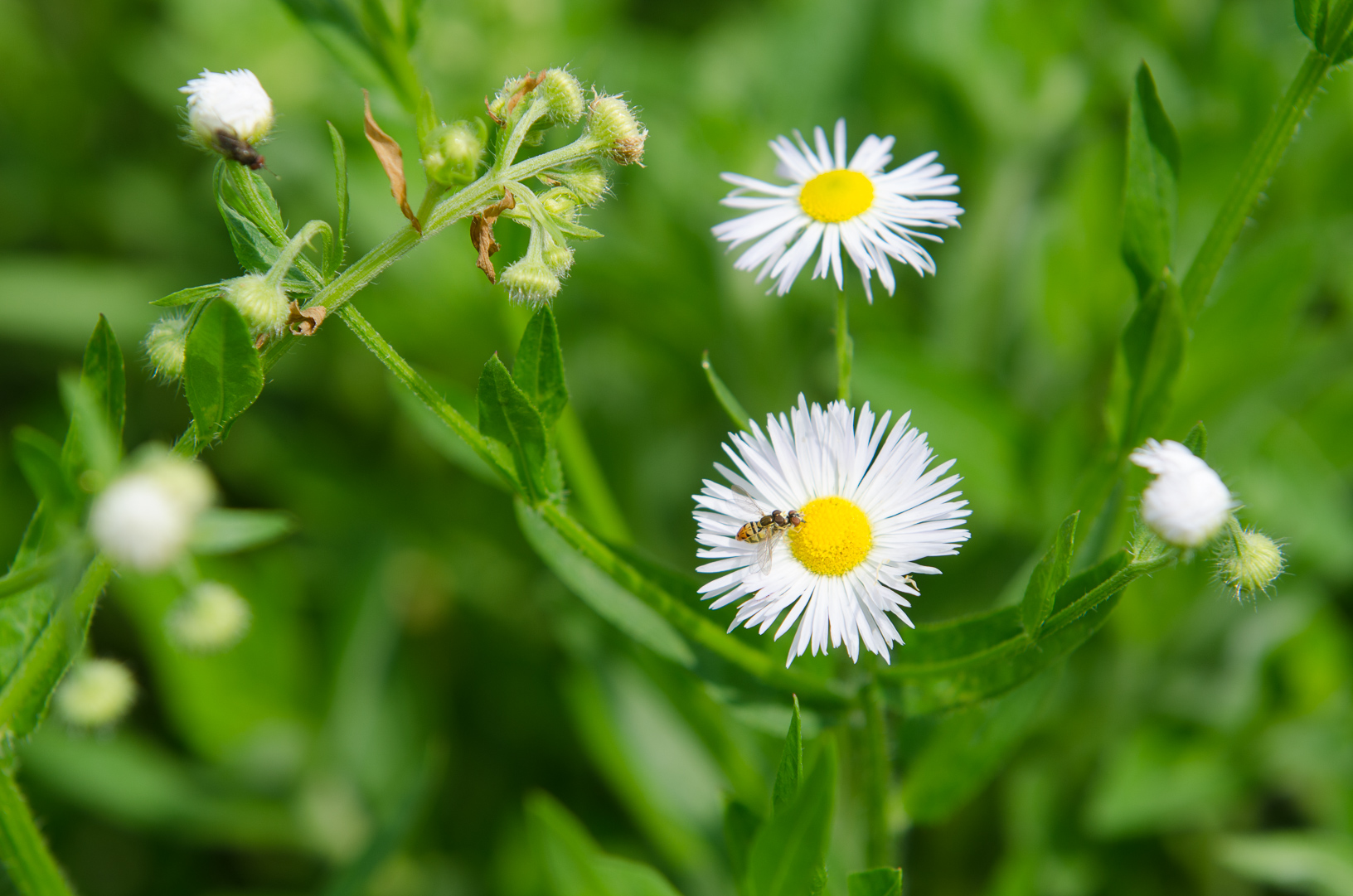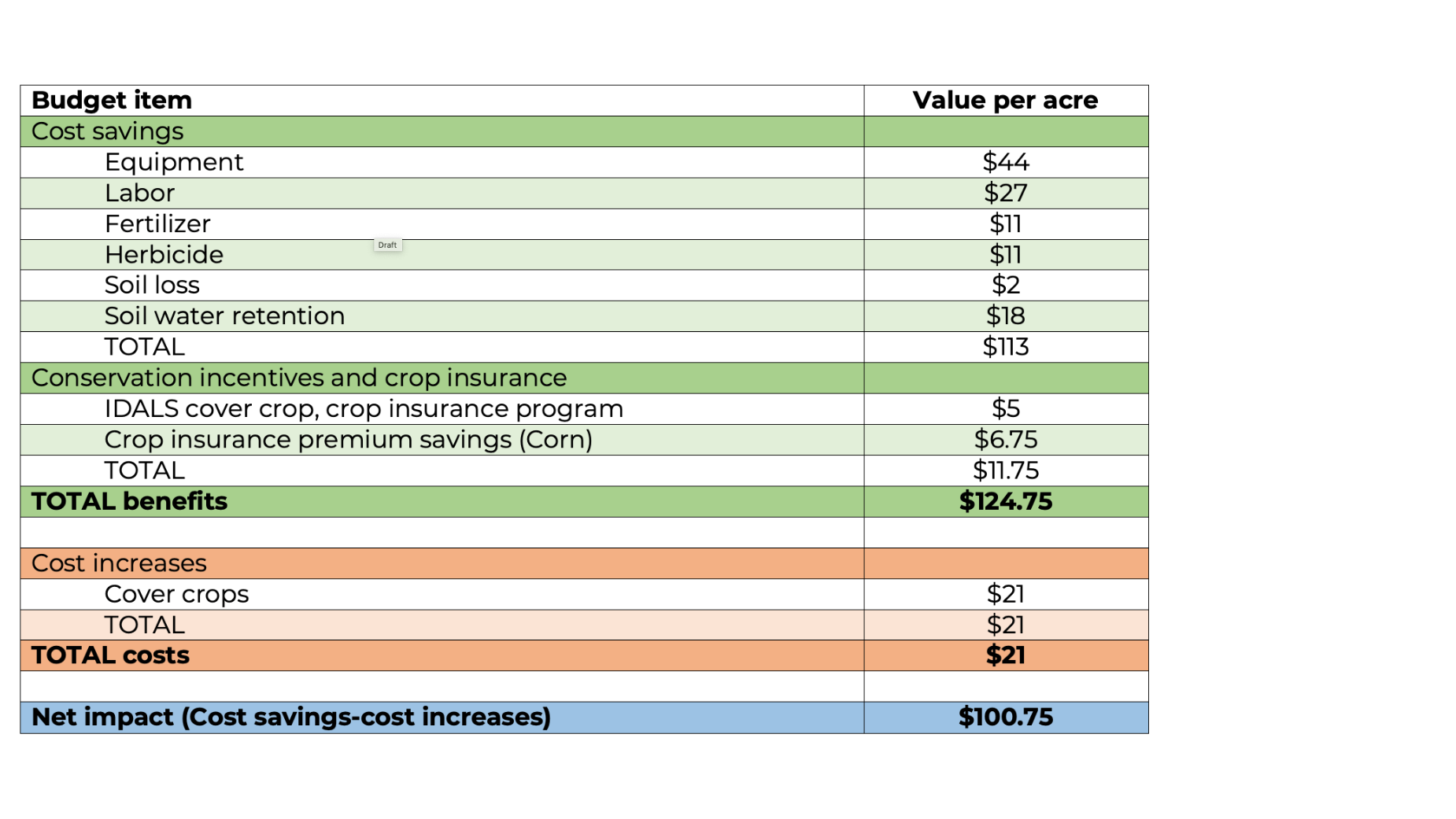
Iowa farmer Wayne Fredericks says his integrated cropping system saves time and money and protects natural resources. (Photo: Joseph L. Murphy/Iowa Soybean Association)
Change in weather shifts Iowa farmer’s trajectory, saving money and time
June 19, 2020 | Bethany Baratta
Wayne Fredericks and his wife Ruth began farming in northern Iowa in the early 1970s. For the first 19 years of their farming careers, their farm was managed conventionally: corn stalks were plowed and soybean stubble was tilled before planting.
It was a change in the weather that altered their conventional farming practices — for the better.
“In the winter of 1991, we had an early freeze and I didn’t get any of our fall plowing done,” Wayne recalls. “I sat in my office in December wondering what the heck I was going to do.”
Wayne stumbled upon an article in a farm magazine about a farmer no-tilling soybeans. Wayne was intrigued. Later, a discussion with his John Deere implement dealer turned into a proposition. The dealer was going to get a no-till drill to run a trial, and he would lend it to Wayne if he was interested.
The result: good growth and weed control, with outstanding yields.
“I was hooked,” Wayne says. “I went fully from plowing to no-till soybeans in one fell swoop.”
Even though Wayne was initially wary of no-till corn, he has found a way to optimize the economics of his corn fields using a strip-till system. He applies phosphorous and potassium in the fall in those strips with the goal of maximizing nutrient efficiency and reducing nutrient loss. In the spring, he no-tills into those fall-built strips. He’s found the strips more suitable for planting; 7 to 10 degrees warmer and drier. It works well in his system, especially since he’s operating without additional labor.
Conservation helped address weather and water quality concerns
When Wayne made the decision to implement cover crops, his motivation was improving water quality, not economics. Over time however, he found that combining cover crops with no-till generated substantial financial value to his operation.
In 2008, Iowa experienced record flooding. Water inundated farms, flowed off agricultural fields and flooded communities downstream.
“The practices that we as farmers engage in on the land can make a significant difference to the communities downstream, not only in quality of water, but the quantity of water,” Wayne says. “This is huge to those downstream communities if we can make our landscape more like a sponge and soak up more of this water and help prevent some of this flooding.”
Wayne first got involved with cover crops through trials run by the Iowa Soybean Association. The trials aimed to learn what species worked well on his farm and how the cover crops affected crop yields. Partaking in these trials heightened Wayne’s awareness of cover crops and the benefits they have for water quality – including meeting Iowa’s nutrient reduction goals.
On-farm water quality monitoring through the Iowa Soybean Association revealed nitrogen levels at 13.23 mg/liter in the water draining off of Wayne’s soybean fields – higher than the drinking water standards at 10 mg/L. When the field was in corn, the samples revealed a nitrogen rate of 13.98 mg/L.
After implementing cover crops into his system in 2016, Wayne saw a vast improvement in nitrate levels.
“I planted into the tall green cereal rye, and our tiles tested at 4.17 mg/Liter, a 70% reduction in nitrogen,” Wayne says. “I was starting to get excited when I saw results like that.”

A pollinator habitat on Wayne's farm near Osage. (Photo: Joseph L. Murphy/Iowa Soybean Association)
Other conservation efforts
Wayne is a believer in collaboration, cooperation and conservation. He’s worked with various groups, including the Iowa Soybean Association, to demonstrate how additional practices on the farm can help move the needle on water quality in Iowa.
His first project was working with the Natural Resources Conservation Service (NRCS) in 1984 to design and plant a windbreak on the farm. Since then, he’s constructed waterways and worked with ISA to monitor nutrient levels from water leaving his farm.
He was the first to install a bioreactor in Rock Creek Watershed in Mitchell County.
He’s a part of the Monarch Collaborative and has seven strategically placed pollinator habitats on his farm.
A close look at Wayne’s economics
Along his conservation journey, Wayne has found that reduced tillage practices and the implementation of cover crops has improved soil structure and increased organic matter in his fields while reducing soil loss and fertilizer input costs.
Results from various studies showed cost and advantages in several areas of his operation, including equipment and labor cost savings, lower fertilizer costs, improved weed control, and reduced soil loss. The partial budget table below demonstrates the average costs and savings associated with Wayne’s transition to reduced tillage and cover crops:

Wayne saves $44 per acre on equipment costs and $27 per acre on labor costs. Weed control provided by the cover crops saves Wayne $11 per acre on herbicide.
Wayne’s transition to conservation practices has also provided financial benefits through increased soil organic matter content. Studies in cooperation with Jerry Hatfield, the former director of the National Laboratory for Agriculture and the Environment, have shown a 2.5% increase in soil organic matter from 1990 to 2015. Estimates through NRCS shows that a 1% increase in organic matter generates, on average, $18 per acre in moisture retention and $11 per acre in mineralized nitrogen and phosphorous (represented in the table as fertilizer cost savings).
- Also noted is $5 per acre from the Iowa Department of Ag and Land Stewardship (IDALS) for the implementation of cover crops*Note: Wayne no longer qualifies for federal cost-share for his practices due to time/year commitments on payments.
- Wayne also finds (based on his historical yield records) that his production is at lower risk from poor weather conditions, which has led him to find crop insurance savings by reducing his revenue protection (RP) coverage from 85% to 75% and switching to Price Loss Coverage (PLC) program adding Supplemental Coverage Option (SCO). These changes have saved Wayne $6.75 on corn acres.
Considering these two other factors and subtracting $21 per acre in cover crop costs leaves a net savings of $100.75 per acre through conservation.
Solutions
Wayne allows the research and trial data to help drive decisions on his farm. He knows, however, that federal and state policies also influence farm-level decisions, just as the 1985 Farm Bill placed an emphasis on conservation and reduced tillage methods (from moldboard plowing to chisel plows). Evaluating these decisions on a farm-by-farm basis can aid other farmers in their decision making too, he says.
“Maybe it’s hard in the beginning to point out the profitability associated with cover crops,” he says. “But I think in the long term—like no-till is in relation to moldboard plowing—it’s the right thing to do.”
He says looking at conservation financing in a community lens can raise the conversation surrounding conservation. For example: reducing tillage has a benefit to farmers in the context of preserving the soil. It also benefits downstream communities through increased water-holding capacity, decreasing flooding risk.
But how can farmers benefit financially from making management decisions which affect soil and water quality?
“We have to find a way to be able to measure and denote land that has been improved and eventually I think we can capture a value for that,” Wayne says.
Wayne says conservation practices and improved soil health should be figured into farmland values, much like Corn Suitability Ratings are for farms in Iowa.
“When you really sit down and put value on soil carbon and what the inherited value of that organic matter is to the soil, there’s some real value there,” Wayne says.
The $72.50 per acre nutrient and water holding capacity benefit from a 2.5% organic matter increase in 25 years means increased benefits to soil health, which Wayne says should be accounted for.
“My field should be more productive than the farmer across the field that has the same soil and does full-width tillage,” Wayne says. He added that incentives like reduced crop insurance rates should be provided for more productive acres with increased soil health scores, since they reduce risk potential.
In his conversations with realtors, Wayne’s learned that the possibility of assigning a soil health score, much like Iowa’s Corn Suitability Rating, could be a reality within the next decade. That value, then, would be directly connected to the farmer making those improvements, Wayne says.
“If you have a farm worth more in carbon credits, why wouldn’t that be worth more as an asset? That’s where I think you start to tie some of this stuff together and then you start get some drive behind the practices,” Wayne says.
Wayne has engaged with various stakeholders interested in driving the conversation surrounding the financing and economic benefits of improved soil health. But it’s a conversation in which everyone could find value, he says.
“You have to engage everybody on it,” Wayne says. “A simple change in tillage practice is a multi-benefit for the tenant and landowner. It increases soil health, and also has benefits in lowering the costs of fuel, equipment and labor.”
New programs like the Soil and Water Outcomes Fund are positioned to provide financial incentives to farmers and landowners to implement agricultural best management practices and monetize the resulting environmental benefits by selling verified outcomes to the beneficiaries. The Fund helps elevate the incentives and opportunities to grow conservation practices in the state.
“I think there are opportunities ahead,” Wayne says. “We just need to start talking about it.”
Contact Bethany Baratta at bbaratta@iasoybeans.com.
Back